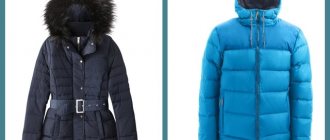Shrinkage is typical for clothes made from natural materials. Any natural fibers change their properties, swell and twist after washing.
Knowing that natural fabrics shrink when wet, manufacturers take this feature into account during production, leaving the necessary allowance for the product to shrink. This should be taken into account when choosing clothes: you should not take things made of natural cotton, viscose and linen that fit snugly; the item should be a little loose.
In order to understand the reason for the deformation of the canvas after exposure to moisture, it is necessary to know the composition of the material. Any fabric consists of a weft and a warp. The warp threads are parallel to each other, and the weft threads are woven into them and intertwined with each other. The density of the fabric depends on how far apart the threads are located.
There are several main reasons why clothes shrink after washing:
- Elastic deformation. In order for the scattered threads to become a piece of fabric, a huge amount of work is carried out. The fibers are processed, bent and stretched many times, so they remain in “tension”. When water gets on them, the threads “relax” and the clothes shrink. Most often, shrinkage after washing occurs along the warp threads, the weft fibers undergo elastic deformation less often.
- Swelling of fibers. Threads made from natural materials are porous and hygroscopic. This means that they are able to absorb moisture and increase in size. If the fabric is not dense, then there are gaps between the threads that fill when it swells. In materials of medium and high density, deformation can occur due to a sharp increase in specific density. In simple terms, the swollen fibers do not have enough space and become intertwined and twisted with each other.
Proper care of the fabric will ensure long life and excellent appearance of things. Always pay attention to the symbols on the label. These pictograms will tell you whether clothes or bed linen can be washed in a machine, at what temperatures, at what speed they can be wrung out and how to dry them properly. Washing at temperatures higher than recommended and excessively curling can cause clothing to shrink a size or several.
Clothes shrink the least when washed by hand. You should choose this one if there are few things or the dirt is small. Soak the product in slightly warm water and rinse. Squeeze a little with your hands or let the excess liquid drain on its own. Depending on the composition of the fabric, choose horizontal or vertical drying.
Shrinkage and its causes
If you are not careful when processing cotton fabrics (for example, chintz, cambric, satin and others), they can:
- sit down (be subject to deformation);
- turn yellow;
- shed.
The material shrinks both in length and width. In order to properly care for such fabrics, you need to understand why their size changes.
Why does 100 percent cotton shrink?
The reduction in the original size of cotton is largely due to the structure of the fibers.
The raw material for the production of the material is the fluffy mass of cotton fruits. Textile threads are thoroughly stretched during the manufacturing process . When in contact with water and heat treatment, cotton fabrics swell, and when dried, they change length (shrink).
If decating was carried out correctly during production, the scale of shrinkage is much less. Decatation is the processing of textiles (wet-thermal) during the production process. Its purpose is to pre-shrink fabrics before cutting them.
Is it not 100% deformable?
Artificial fabrics, as a rule, are not prone to shrinkage , which is why adding them to cotton makes it more stable and elastic. Cotton with elastane (satin, stretch cotton, bengalene, gabardine, polyester) has increased stretchability.
When fibers are combined, the texture of the fabric becomes elastic, firm, and shrinks to a lesser extent. However, we must not forget about the temperature compliance when washing and ironing, determined by the product labels.
Decorating fabrics before cutting
Decatting is a wet-heat treatment of fabrics to shrink them before cutting the product. All fabrics that contain 50 percent or more natural fibers are decatified. These are wool, linen, cotton, hemp, silk, and rayon fabrics. If the product that you plan to sew will be washed, decating is required. If you plan to dry clean (coats, suits), simply iron and steam the fabric.
Before cutting, interlining fabrics are soaked and dried, carefully aligned, but not ironed.
Cotton and linen fabrics are soaked, dried and ironed slightly damp. The silk is soaked and dried. Do not iron with a hot iron. Silk fabrics that may fade are moistened by using a damp sheet in which the silk fabric is wrapped before ironing. Plain silk fabrics are ironed without steam on the reverse side to avoid stains.
For woolen fabrics, moisten the underside with a sprayer. After 8-12 hours folded, the fabric is ironed from the inside out. Thin woolen and wool-blend fabrics simply need to be ironed through a damp cloth.
What fabrics shrink after washing?
Shrinkage after washing is typical for many fabrics. Natural materials are most susceptible to it due to the porosity of the thread structure. Artificial fabric is stronger and less susceptible to deformation.
Clothes can shrink not only along the width of the material, but also at the seams. Areas with multiple seams - pockets, darts, collars and cuffs - suffer the most from wet processing. In addition, even if the main material of the product was cut correctly, with allowances, the cotton threads for the seams can shrink significantly on their own.
Linen, viscose and cotton are the most deformed. These fabrics can even shrink several sizes if not washed correctly. Moreover, if the cutting pattern did not include allowances for shrinkage, the clothing may shrink even in wet weather.
- What to do if your jeans are stained during washing?
To choose the fabric that shrinks the least after washing, use the table:
| Shrinkage percentage | Type of fabric |
| 1,5 | Capron |
| 2,5 | Semi-capron |
| 3-4 | Viscose, staple |
| 3-4 | Wool blend |
| 3-5 | Satin, percale, poplin and chintz |
| 4-5 | Silk |
| 5-6 | Velveteen |
| 6-7 | Linen and natural wool |
Why do tissues become deformed?
Shrinkage is a change in the size of fabric after improper washing and drying, excessive steam and heat treatment. Your favorite sweater can easily shrink by a couple of centimeters if you do not follow the instructions for caring for it. The labels on clothes are sewn on for a reason - they tell you how to properly wash, dry and iron the item.
So why can any textile shrink in principle? The fact is that fabric is formed by weaving fibers together. The susceptibility of a material to deformation is influenced by the origin of the fibers and the method of weaving. For example, both satin and denim are made from cotton, and these are completely different products, subject to “shrinkage” to varying degrees.
Today, two types of fibers are used in production: synthetic and natural. The first ones are created on the basis of oil. Artificial polymers practically do not compress; organic threads are another matter. Natural fabrics are elastic; their weave is much looser, which leads to stronger stretching. This is how the structure of the material changes, the thing is deformed.
It is important to follow the manufacturer’s recommendations, wash and iron products according to the rules, without violating the maximum permissible temperatures.
Shrinking cotton
Need to shrink a cotton cardigan? This will work if it is sewn correctly. If the threads do not go as required, then nothing will work.
How to shrink a large cotton dress or suit? Experts recommend setting the machine to the hottest water possible with a strong spin. But you can only wash white clothes this way.
It is better to wash colored clothes by hand. Moreover, you need to remember the rule: when kept in boiling water for 5 minutes, the item decreases by 1 size. Accordingly, if you keep it in boiling water for 15 minutes, it will decrease by about 2-3 sizes.
After hand washing, it is advisable to use an electric dryer. If even after these actions the item has not decreased significantly, repeating the procedures is useless.
Nothing can be done. The clothes will remain the same size, but the structure of the fabric, especially colored ones, can be damaged by hot water.
Shrinkage of our products
The fabrics from which we sew bed linen are also subject to shrinkage: usually we are talking about 2-5%. The exact figure depends on the material and even the batch of fabric. So, non-mercerized cotton shrinks more than mercerized cotton, and Tencels shrink even less. Moreover, for one fabric, the degree of shrinkage in the weft and warp is slightly different. As a result, for a sheet with an elastic band measuring 2x2 meters, you need to add 4-10 cm to each dimension when cutting.
Since our motto is “Size to size”, when cutting we always make the necessary addition to the dimensions, designed for shrinkage of the material after 1-2 washes at a temperature of 40°C. Therefore, when placing an order in the Size to Size online studio, you can be sure that after washing the products will shrink to the specified size.
What do we wash?
It is impossible to unequivocally answer the question of how to fit an item to size, because shrinkage can be either insignificant or very large. Inexperienced housewives, throwing a woolen jumper or turtleneck into the machine drum, end up with shrunken doll-sized clothes.
A thing made of viscose, for example, will not shrink so much. And 100% synthetics do not shrink at all. But if the shirt or pants contain at least 50% natural fibers, then there is a chance to return the stretched item to its previous shape.
You can wash trousers or stretch jeans in hot water. But you don't need to use boiling water. 60°C is enough for the thing to become addicted. Spinning in a drum will increase shrinkage, but high speeds are unacceptable for T-shirts, tank tops, panties and other knitted items.
- Fabric shrinkage: does linen shrink when washed?
How to wash viscose to reduce the size of the item? Blouses and dresses made of viscose practically do not shrink, but also do not stretch. And if the product contains other fibers - wool, acrylic, cotton, then deformation is inevitable. In this case, they resort to temperature changes during washing and drum drying.
It is difficult to return the original size to a stretched swimsuit or tights, because these things are usually made of synthetics. Denim shorts can be boiled to make them shrink, and a wool sweatshirt is recommended to be hand washed in hot water.
Washing in a machine does not always give the desired result. Be prepared for surprises when removing an item of clothing from the washing machine after a high-temperature wash at maximum speed.
Wool
Woolen clothes shrink from hot water and contrast showers. You can wash wool trousers so that they fit the same size in water at a temperature of 50 - 60 ᵒC. After 10 minutes, the item is lowered into a basin of cold water. Wool-blend sweaters and other items are also washed, but it is not recommended to soak a cashmere sweater for a long time. To reduce it by 1 size, you should wash your wool sweater only in warm water with the mildest detergent possible.
You can wash a woolen dress to make it shrink in a machine, but there is a risk of shrinking the fabric too much. It is better to wash a woolen item so that it shrinks according to this principle:
- soak the sweater in water at a temperature 20 ᵒC higher than recommended with wool products and leave the product in it for 15 - 30 minutes;
- rinse the jacket in ice water;
- lay the product on a dry terry towel and roll it up to remove excess water;
- dry flat with a hairdryer.
Using a similar method, you can wash both a sweater so that it shrinks and a woolen dress. But for a woolen hat, a device such as a blank or a 3-liter jar is useful; the product is placed on it after washing.
Cotton
How to wash cotton so that the item becomes 1 - 2 sizes smaller? Planting a cotton item is easy using the boiling method. If you hold the cotton in water for 5 - 10 minutes, it will shrink to size. In this case, the item may lose color and shape.
For white cotton items, machine washable. For example, a judo kimono can be thrown into a drum and set to 90 degrees.
How to wash without shrinking clothes
The main thing in this matter is to trust the manufacturer. It seems that tags on clothes only get in the way and are completely unnecessary? - this is wrong. They contain all the detailed information about the specific composition of the item. The mode, power, temperature are indicated. Pay attention to this and you will not make mistakes. If it has already happened, then do not panic, there is an opportunity to fix everything. We wrote above exactly how to do this with various materials. Now check out the “useful benefits”:
- Sneakers, shoes, boots should only be washed with a cloth. Remove all laces from your shoes, otherwise the drum will jam them. Place 2-3 pairs of sneakers in the washing machine. Place 1-2 rags there for dust and floors. This way you will kill two birds with one stone. Wash sneakers and rags, eliminate the noise of electrical appliances.
- Wash the drum with baking soda. Machines that have been in service for years wear out. The soda will clear them of possible plaque, and after washing the clothes inside will become velvety and soft.
- Pour gels and conditioners into beautiful jars for liquid soap. This will give an aesthetic look to your bathroom.
- Don't wash baby clothes with a lot of powder, especially if it's cheap. These are chemicals that can cause skin allergies in children. Therefore, use baby products or add powders to a minimum.
- Wash sports items separately from everything else. They stretch better and won't ruin other clothes. Because sports brands often produce very bright clothes that tend to fade.
Thank you for your interest in our articles. Wash your clothes correctly, using our material as a guide. Then you will definitely not make mistakes, and your favorite clothes will last for many years.
Add AN to your sources so as not to miss important events - Yandex News
- Chaliapin's 42-year-old wife wrote to him before her death that he had infected her with coronavirus
- From a mole to a tumor - one step, or the first 6 “bad” symptoms
- Mathematician Alexander Losev: With digital technologies we are moving into the Middle Ages
- The victorious Social Democrats in Germany are implementing the ideas of Marx
- Writer Alexander Lapin: “Three decades after the collapse of the USSR, we rolled back a whole century”
- Those arrested for beating a passenger in the Moscow metro told their version of what happened
- How to wash things so they don't shrink?
Become a member of the CLAN and every Tuesday you will receive the latest issue of “Arguments of the Week” with a discount of more than 70%, along with exclusive materials not included in the newspaper. Get premium access to a library of the most interesting and popular books, as well as an archive of more than 700 published issues for FREE. In addition, you will have the opportunity to benefit from free legal advice from our experts for a whole year.
- Enter your email address, then select any convenient payment method for your annual subscription
- Scan the QR. In the Sberbank Online application that opens, enter the annual subscription cost (490 rubles). Then send the confirmation code by email
Or
Anti-shrink treatment methods
They try to prevent shrinkage and deformation of fabrics or, at least, reduce them in the stages prior to sewing clothes. There are special methods for this:
- mechanical. An elastic band is placed on the fabric and pressed tightly. In this form, the material is rolled through hot rollers. As a result, the tension is removed from the tape, and the fabric undergoes forced shrinkage;
- chemical. Its essence lies in the preliminary impregnation of the fibers with a solution of formaldehyde, which reduces their swelling when exposed to moisture, and consequently, deformation;
- tracking. This method is most often used for knitted materials. Rolls of fabric are laid out on shelves in a room with a given humidity and left for a long time. After the shrinkage process is completed, the canvases are put into production.
The most effective methods of anti-shrink treatment include heating with dry steam and decating. Let's learn about this method in more detail.
Quality of clothes
www.liveabout.com
The higher the quality of the clothing, the less likely it is to shrink. Special finishes and manufacturing technologies that prevent shrinkage are more often used by higher-end manufacturers who care about product quality. Because most people don't want their clothes to shrink, Gagliardi notes. Customers want to be able to wash their clothes over and over again and keep wearing them, and for them to continue to look the same as when they bought them.











